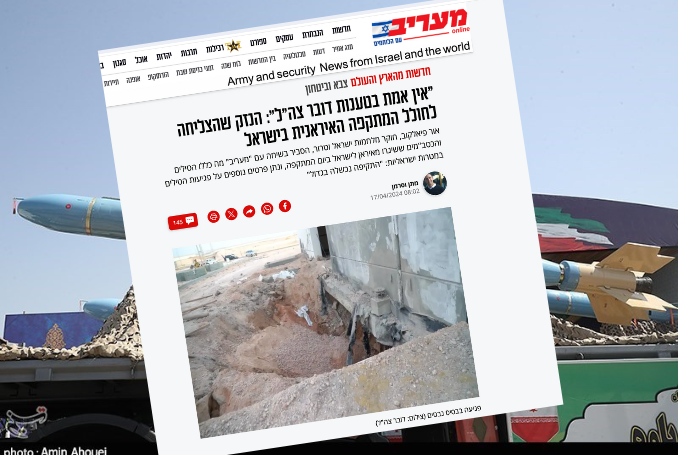
From video analysis, at least four missiles hit the Ramon base, contrary to the Israeli army’s claim of seven interceptions.
Or Fialkov, a researcher specializing in Israel’s wars and terrorism, provided insights to the Israeli newspaper Maariv on Wednesday, debunking claims by the Israeli army that the attack did not cause damage in Israel.
Weapons Used
According to the report, Iranian retaliatory attack, dubbed ‘True Promise’ by Tehran, comprised approximately 185 Shahad 136 anti-aircraft missiles, along with the Shahad 238 jet variant capable of reaching speeds up to 500 km/h.
Additionally, Iran reportedly launched several dozen cruise missiles and about 110 ballistic missiles, with roughly half failing to reach their intended targets in Israel, Iraq, Syria, and Jordan, resulting in casualties.
At least six missiles were intercepted by American destroyers equipped with the Aegis anti-missile combat system, akin to Arrow missiles.
Various long-range ballistic missiles were fired at Israel from multiple launch sites in Iran, though not all missile types were deployed.
Among those utilized were the Khyber Neighbor, with a range of 1,450 km and a 500 kg warhead, and the Imad, introduced in 2016 with a range of approximately 2,500 km and a 750 kg warhead.
Additionally, the Kader 110, an upgraded version of the Shehab 3, was employed, boasting a range of 1,800-2,000 km and a warhead ranging from 650 kg to 1,000 kg.
The Shehab 3B, with a range of 2,000 km and a 700 kg warhead, was likely utilized as well.
According to Fialkov, however, more advanced missiles such as the Sajil, with a range of 2,500 km and a 1,500 kg warhead, and the Khoramshahr, with a range of 2,000 km and an 1,800 kg warhead, were not deployed, and the Iranian army “may have been saving them for future attacks”.
Damage Caused
Citing a map published by an Iranian website, Fialkov said that Iranian forces attacked three main bases: the Hermon base, the Nevatim base, and the Ramon base.
The Israeli army claimed that only the Nevatim base suffered minor damage, along with a road in the vicinity of the Hermon base, while the Ramon base was not affected at all.
The researcher, however, explained that, from video analysis, at least four missiles hit the Ramon base, contrary to the Israeli army’s claim of seven interceptions. Video analysis suggests at least four direct hits by missiles, not interceptors.
‘True Promise’ – Iran’s Historic Attack is Rooted in Palestine’s Freedom Struggle
Moreover, according to Fialkov, “a UAV was able to penetrate and hit the Hermon area” contrary to Israeli army’s claims that no drone had entered Israeli territory.
Satellite analysis of the Ramon base, according to the report, indicated “up to five hits in the base, several warehouses, maintenance facilities” and various areas around the base.
Regarding the atomic reactor in Dimona, Fialkov explained that satellite images indicate “one hit to one of the structures in the nuclear reactor and up to two hits around the base.”
Fialkov still estimated a high interception rate of approximately 84 percent, but “not comparable to the numbers” provided by the Israeli army, “which gave a feeling that all Iranian threats were intercepted.”
(The Palestine









As soon as Iran’s retaliatory attack ended, Israel was already desperately covering up its losses and attempting to prevent Israelis from posting videos of Iranian missiles striking their targets.
A senior U.S. government official had acknowledged that at least five Iranian missiles struck the Nevatim Air Base, while at least four others struck the Negev Air Base. In addition, an Israeli military intelligence base was also hit real hard by Iranian missiles. Moreover, it’s believed those three military bases that Iran struck were damaged very heavily.
According to reports, Israel spent a total of $1.35 billion to attempt to shoot down all of the incoming Iranian drones and missiles. On the other hand, Iran only spent $27.4 million to carry out ‘Operation Truthful Promise’. All of the drones used in this particular operation were Iran’s oldest drones. As for missiles, the ones used by Iran in this operation were nowhere close to being its most powerful missiles.
Iran’s retaliatory attack was indeed an undeniable success. Tehran, had also informed regional countries as well as the United States about its planned attack, 72 hours before it began. And yet, “Israel’s defense shield”, consisting of three layers (Iron Dome, David’s sling, and the Arrow Missile Defense System), along with the help of the U.S., UK, France and Jordan, were still not able to stop Iran from precisely striking those three bases, which had been involved in Israel’s terrorist attack against the Iranian embassy in Damascus, back on April 1st.